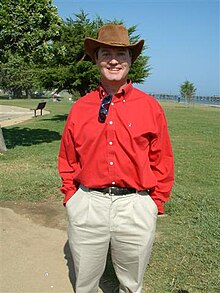Joseph Polchinski
Joseph Polchinski | |
|---|---|
 Joe Polchinski in Santa Barbara | |
| Born | May 16, 1954 White Plains, New York |
| Known for | D-branes |
| Awards | Dannie Heineman Prize for Mathematical Physics (2007) Dirac Medal (2008) |
| Scientific career | |
| Institutions | University of California, Santa Barbara |
| Doctoral advisor | Stanley Mandelstam |
Joseph Polchinski (born on May 16, 1954) is an American theoretical physicist and string theorist. He graduated from Canyon del Oro High School in Tucson, Arizona in 1971, obtained his B.S. degree from Caltech in 1975, and his Ph.D. from the University of California, Berkeley in 1980 under the supervision of Stanley Mandelstam. After postdoctoral positions at SLAC (1980–82) and Harvard (1982–84) he was professor at the University of Texas at Austin from 1984 to 1992. Since 1992 he has been professor at the University of California, Santa Barbara and a permanent member of the Kavli Institute for Theoretical Physics in Santa Barbara.[1]
Polchinski is the author of the two volume textbook, String Theory, published in 1998. Among his contributions to theoretical physics, D-branes are the best known. In 2008 he won the Dirac Medal for his work in superstring theory.[2]
Polchinski's paradox
In 1990, commenting on the Novikov self-consistency principle (in relation to sending objects or people through a traversable wormhole into the past, and the time paradoxes that could result), Polchinski raised a potentially paradoxical situation involving a billiard ball sent through a wormhole which sends it back in time. In this scenario, the ball is fired into a wormhole at an angle such that, if it continues along that path, it will exit the wormhole in the past at just the right angle to collide with its earlier self, thereby knocking it off course and preventing it from entering the wormhole in the first place. Physicist Kip Thorne deemed this problem "Polchinski's paradox". Later students of the whimsical problem came up with solutions which managed to avoid any inconsistencies, by having the ball emerge from the future at a different angle than the one used to generate the paradox, and deliver its younger self a glancing blow instead of knocking it completely away from the wormhole, a blow which changes its trajectory in just the right way so that it will travel back in time with the angle required to deliver its younger self this glancing blow.[3]
2012 Paper on Black Holes
In July 2012, Polchinski, together with two of his students — Ahmed Almheiri and James Sully — and fellow string theorist Donald Marolf at the University of California, Santa Barbara (UCSB), published a paper whose calculations about black hole radiation seemed to suggest that either Relativity Theory's equivalence principle is wrong, or else a key tenet of quantum mechanics is incorrect.[4]
Bibliography
- Polchinski, Joseph (1998a), String Theory Vol. I: An Introduction to the Bosonic String, Cambridge University Press, ISBN 0-521-63303-6
- Polchinski, Joseph (1998b), String Theory Vol. II: Superstring Theory and Beyond, Cambridge University Press, ISBN 0-521-63304-4
References
External links
- People from White Plains, New York
- 1954 births
- Living people
- String theorists
- American physicists
- Harvard University staff
- California Institute of Technology alumni
- University of California, Berkeley alumni
- University of Texas at Austin faculty
- University of California, Santa Barbara faculty
- Theoretical physicists
